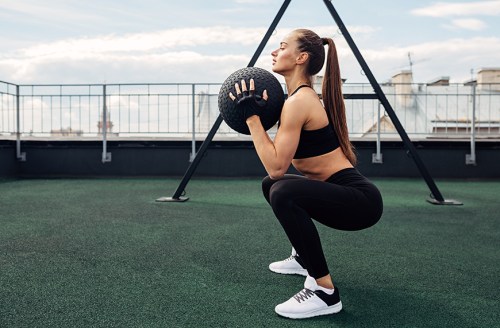3 Trainer-Approved Ways to Practice Sitting Back Deeper Into Your Squats
Squats can be tricky. Learn how to sit back in a squat correctly using this easy-to-follow, three-step process. You'll be a pro in no time.

Squats are harder to perfect than you might think. After nailing down the form—which can be a challenge in itself—you still need to learn how to sit back in a squat properly without falling over. Let’s just say it takes a little practice, and if you don’t put in the time, you won’t get nearly as much out of the exercise.
“One of the most effective exercises to strengthen and tone your lower body is the traditional squat. But how you perform the squat should be carefully considered to optimize gains and minimize injury potential,” says Kirsty Alexander, a Kansas City, Missouri-based trainer and instructor at Health House. “‘Sitting back’ into the squat is an effective coaching method to help individuals perform this exercise correctly and achieve lower-body strength.”
While there are many different ways you can practice sitting back into your squats correctly, Alexander has a three-step process that will turn you into a pro. Here’s exactly how to sit back in squat.
How to sit back in a squat properly
1. Hold something in front of you
According to Alexander, the best way to begin practicing the “sitting back” technique is to hold onto something in front of you. “This allows you to really sit back in your squat while keeping your chest up,” she says.
- 1.If you’re at home, use a countertop or table. And if you’re at the gym, a Smith machine bar will do the trick.
- 2.Place your feet just outside of shoulder-width with your toes slightly pointed out.
- 3.Grip your hands on the object in front of you. Putting all your weight into your heels, hinge at your hips by pushing your glutes back, lowering into a squat position. You want to form a 90-degree angle at your knees.
Pro tip: Once you feel comfortable squatting to that 90-degree angle, challenge yourself to break parallel by squatting deeper. This will start to activate the large posterior muscles—your hamstrings and glutes.
2. Use a weighted object
Feeling pretty comfortable holding onto a stationary object? Now Alexander says it’s time to move onto a weighted object. “A medicine ball, dumbbell, or household object works great,” she says. “You’ll perform this exercise the same as above, but this time the weighted object in front of you won’t be stationary.”
- 1.Place your feet just outside of shoulder-width with your toes slightly pointed out.
- 2.Holding the weighted object in your hands out in front of you, hinge at your hips by pushing your glutes back and lower into a squat position. Remember to tighten your core and shoot your weight into your heels as you form a 90-degree angle at your knees.
- 3.This will be more of a challenge, but it still counterbalances the feeling of falling back in the “sitting back” technique as you get more comfortable with the feeling.
3. Stand in front of a chair, couch, or bench
Ready to ditch the weighted object? Alexander says to take away the weight out in front of you and find a bench, chair, or couch—something you can lower your butt onto.
- 1.Stand with a bench, chair, or couch behind you. Your feet should be just outside of shoulder-width and your toes should be slightly pointed out.
- 2.Place your hands out in front of you (with no weight). Focus on tightening your core, hinging at your hips, and pushing your glutes back as you slowly lower yourself down to a sitting position on the bench.
- 3.Before driving up, check your form. Your knees should align with the balls of your feet, weight is in your heels (you should be able to wiggle your toes), chest is up, and core is tight.
- 4.Drive up through your heels with your knees staying out, squeezing your glutes at the top.
Pro tip: Once you’ve mastered this practice, try lightly tapping your glutes on the bench while maintaining good form. Soon enough, you won’t even need the bench and you’ll be sitting back in squats like a pro.
Does your form still need some work? Watch this video:
Sign Up for Our Daily Newsletter
Get all the latest in wellness, trends, food, fitness, beauty, and more delivered right to your inbox.
Got it, you've been added to our email list.










